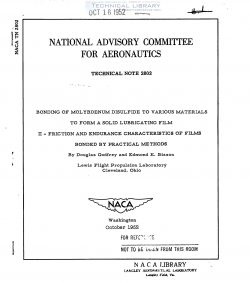naca-tn-2802
- Version
- 71 Downloads
- 732.94 KB File Size
- 1 File Count
- January 17, 2017 Create Date
- January 17, 2017 Last Updated
National Advisory Committee for Aeronautics, Technical Notes - Bonding of Molybdenum Disulfide to Various Materials to Form a Solid Lubricating Film - II - Friction and Endurance Characteristics of Films Bonded by Practical Methods

The use of molybdenum disulfide M082 as a solid-film lubricant is
being extended, particularly in applications where designs or higher
temperatures preclude liquid lubricants, because of the good frictional
and thermal characteristics of M082. An investigation was conducted to
determine (l)'practical methods of bonding M052 to materials to form
solid-film lubricants and (2) friction and endurance characteristics
of films so formed. The results indicated that satisfactory solid-film
lubricants can be formed on a variety of materials by brushing on M083
mixed with a resin-forming vehicle (1 part M082, 2 parts vehicle, by
weight) such as: thinned asphalt¥base varnish,_silicone4base varnish,
or glycerol.
The brushing is followed by air drying, infrared drying, and
oven curing. The choice of the resin-forming liquid vehicle is
governed by the types of application. In the use of asphalt-base
varnish, the cleaning of the specimens was not_critical because of mutual
solubility of the varnish, thinner, and the usual Surface contaminating
greases. Scraping and rubbing tests showed that all the solid—film
lubricants bonded equally well to as-cast, as-rolled, ground, and turned
surfaces, indicating that surface finish did not influence tenacity and
toughness of the films Friction and endurance data obtained under
severe conditions of high sliding velocities and high surface stress shOWed
that solid-film lubricants (between 0.0002 and 0.0005 in. thick) of
M082, bonded with the various resins as well as corn-syrup resin, resulted
in good lubricating effectiveness.
The use of molybdenum disulfide MoSz as a solid-film lubricant'is
being extended, particularly in applications where designs_or.higher
temperatures preclude liquid lubricants, because of the good frictional
and thermal characteristics of-MoSz. The relatively low shear strength
and.high load—carrying capacity of M052 (references 1 and 2) results in
low coefficients of friction and minimization of surface damage, which.are
sustained only as long as the material remains between the sliding surfaces.
The adherence of M032 to one or both of the surfaces determines the lubri-
eating life of the film. An investigation (reference 5) of the basic
mechanism by which M082 is bonded to various materials indicated that,
when M082 was applied to a surface as a mixture of M083 powder and some
liquid vehicle, the liquid decomposed and polymerized to a resin which
bonded the particles of M082 together and to the surface to be lubricated.
| File | Action |
|---|---|
| naca-tn-2802 Bonding of Molybdenum Disulfide to Various Materials to Form a Solid Lubricating Film - II - Friction and.pdf | Download |
Comment On This Post